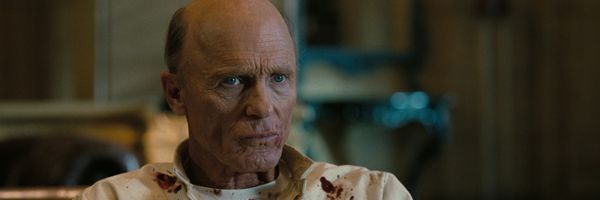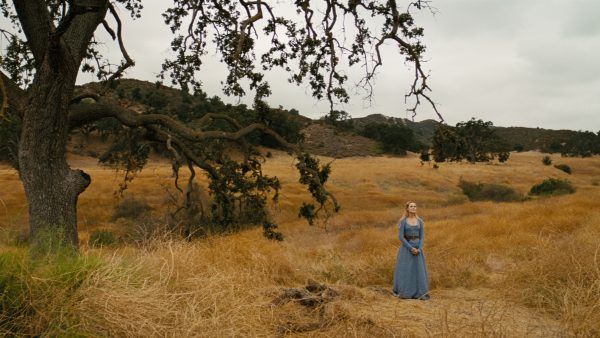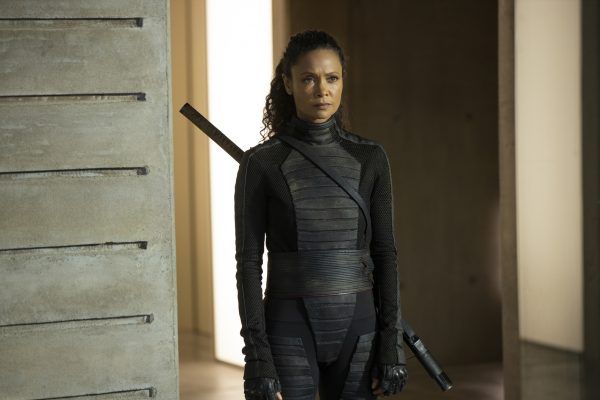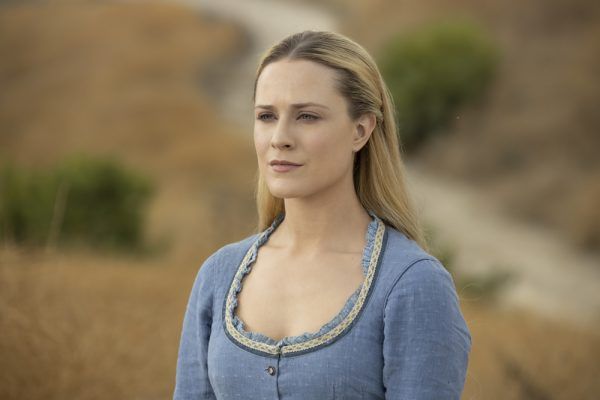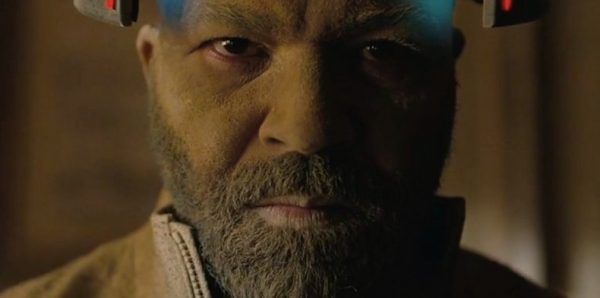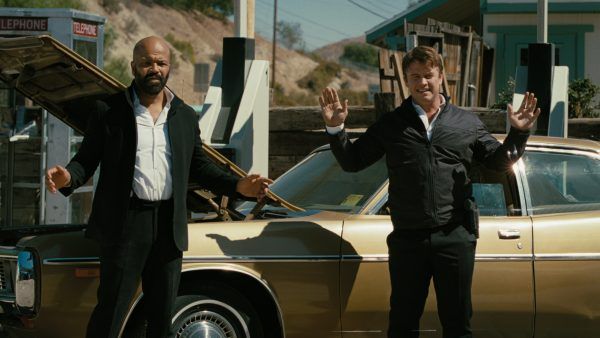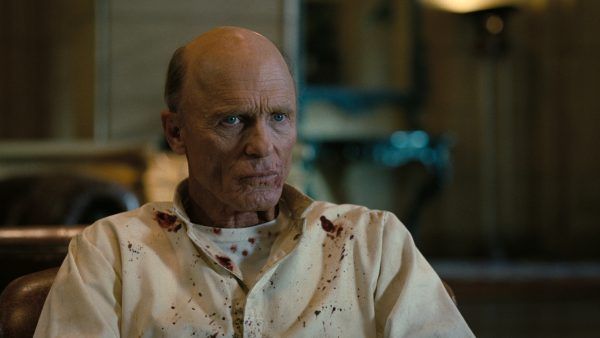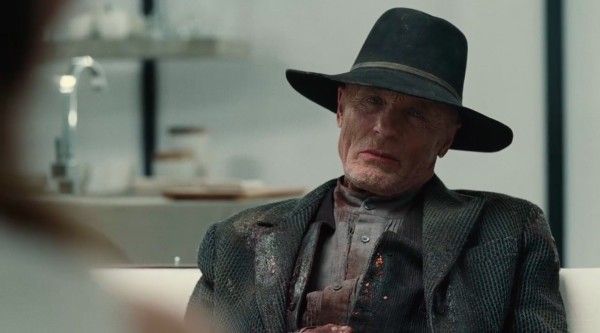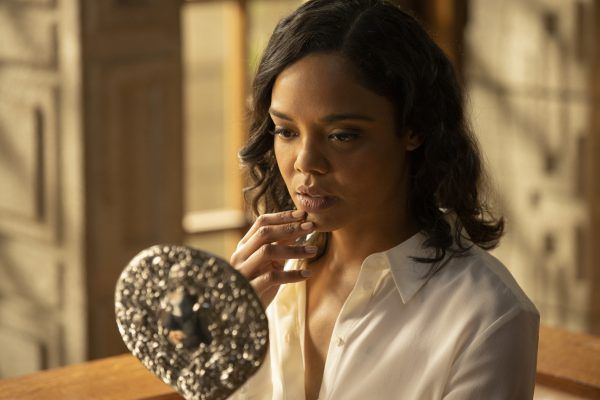Be aware there are SPOILERS for the Westworld Season 3 finale, “Crisis Theory.”
Westworld’s third season may have only run eight episodes, but that doesn’t mean it skimped on the world-building, tech-fuelled philosophizing, or game-changing character reveals, especially in the grand finale. Season 3 wrapped up with an extended episode that packed in a long runtime and not one, but two post-credits scenes, establishing time jumps, delivering long-awaited character payoffs, and wrapping up with some pretty major character deaths along the way. So let’s break down exactly what happened – and what it might mean for Season 4, shall we?
If you’re looking for a full episode recap, you can read Adam Chitwood’s detailed break down here, but for the purposes of discussing the ending, let’s pick things up at Incite, where the core players of the season assemble for one last grand battle and we get several key revelations in quick succession.
Dolores, Caleb, and Maeve
What Happened?
Caleb fights his way through a riot-torn city to make his way to Incite, where Serac has Dolores hooked into the computer, slowly stripping away her memories in his search for the key to the Valley Beyond. When Caleb gets there, he’s scooped up by Maeve, who brings him to Serac. “Why work with Serac?” Caleb asks, hitting on the question of motivation that’s been bumming out a big core of the Westworld audience throughout the season.
“Why else? He’s promised me something I can’t live without,” she answers. And I guess that’s the best we’re gonna get. That promise, of course, is that she’ll be reunited with her daughter in the Valley Beyond… just as soon as Serac gets that key out of Dolores.
Rehoboam reveals the plan Solomon designed for Dolores and Caleb, and it’s not the salvation of the human race, it’s the apocalypse, with a pretty detailed timeline that looks like this:
- Mass Casualty Event (6-10 years)
- Mass Casualty Event (12-16 years)
- Population Collapse (23 years)
- End of Human Civilization (50-125 years)
Naturally, Caleb feels betrayed by his new BFF Dolores. “Why? Why me?” He asks her, but Dolores is strapped in and can’t answer yet. We’ll get back to that answer, but it’s time for the next reveal.
Maeve is generally pretty disgusted with everything she’s seeing and starts to fully understand her situation for the first time. She asks, “You promised me a reunion with my daughter, did you ever intend on keeping your word?” Serac promises that he did, but she replies, “I’m not talking to you, I’m talking to it. Your god, who whispers in your ear and tells you exactly what to say.” It turns out Serac has been little more than a living mouthpiece and puppet for Rehoboam, who quite literally whispers in his ear via transplant.
Turns out Dolores doesn’t have the key to the Sublime. It’s just a memory of her alone in a field (seemingly a nod to “Christina’s World”, the painting Nolan said Dolores was based on). Serac orders Dolores’ entire memory erased and in her final moment, Maeve connects with her, joining her in the field. We hear one of her famous quotes begin: “So many people chose to see the ugliness, the disarray…” Maeve once again begins to plead on behalf of humanity, but Dolores explains that while she was once angry, torn between the impulses to annihilate humankind or, Option B, “tear down their world in the hopes that we can build a new one.” So, basically, what we’ve seen her doing all of Season 3.
Dolores also explains that she never had the key to the Sublime. “I couldn’t trust myself with it, so I gave it to someone I could.” That someone being Bernard, which explains why he was such an essential part of her plan. And so was Maeve. It wasn’t just Caleb that Dolores was teaching to fight in the revolution, and now Maeve has to choose a side. Dolores explains that it wasn’t the moments of horror that stayed with her, but the memories of kindness. The moments of beauty. “There is ugliness in this world, disarray, I chose to see the beauty.” She takes one last look around and disappears from the field, leaving Maeve alone. And just like that, it seems Dolores Prime is not just dead, but gone. Erased in totality. Maybe. We’ll get into that.
Back in the real world, Maeve makes a move to save Caleb. Serac tries to use his kill switch to stop her, but she uses her super-host powers to overheat it (hmm ok, seems a little anticlimactic, but we do love to see Maeve kicking ass). She kills everyone in a hail of gunfire and explains to Caleb that Dolores didn’t pick him for his capacity for violence, but his capacity to choose.
The last major reveal of the scene arrives in the form of a flashback, which shows that Dolores was one of the military training hosts in Park 5 at Westworld. When one of Caleb’s fellow trainees suggested they celebrate their victory the way rich people celebrate their time in the park (rape, he’s talking about rape), Caleb firmly shuts it down. I’m gonna say not raping is kind of the lowest common denominator of decency, but that’s a whole other story.
It turns out that by ordering Dolores' memories erased, Serac sealed his doom because one of her final memories was of Solomon granting her access to the system. Caleb orders Rehoboam to execute the final command, taking control away from Serac, and the A.I. deletes itself. Caleb and Maeve leave Serac bleeding on the floor, pleading with his “brother,” the dead machine, to speak.
In a fitting move for a season that grappled with the anarchy of free will, fighting back against the roles society assigns us, and a protagonist who doesn’t know his full reality, the Season 3 finale riffed pretty heavily on Fight Club. Caleb basically wanders through the episode in the role of the narrator, unaware of his leadership role in an anarchic resistance that bears a striking resemblance to Project Mayhem, right down to people calling him “Sir.” The episode saves the biggest shoutout for last, when Caleb and Maeve look out over the ravaged L.A. cityscape, skyscrapers on fire, and watch the world burn while she delivers her signature line, "This is the new world, and in this world, you can be whoever the fuck you want." I have no doubt someone has already recut that scene with "Where Is My Mind?" playing in the background.
Does That Mean Dolores Is Really Dead?
For all intents and purposes, it certainly seems so. Serac’s form of villainy was especially cruel in the way it targeted Dolores’ very existential being. Not just her death, but her unmaking, so to speak. Memory has been at the core of Westworld’s concept of identity since the very beginning. The hosts’ entire identities were built around “keystone memories.” Memory was Dolores’ path to self-awareness, the trigger that allowed her to grow from her suffering. We saw the same was true for Maeve and Akecheta. Memory was also the core of the entire construct of Season 1; we were only able to experience the dual timelines because of how Dolores experienced her memory – with perfect clarity, all at once.
And that’s not all. The fascination with memory has persisted through the seasons. Memory is at the core of Bernard’s character too. And not just because it was once again the construct by which we experienced the second season. He was literally built by memory, by Dolores, who used her perfect recall to rebuild her first friend, Arnold. Likewise, Ford rooted Bernard in a shared keystone memory with Arnold: the death of his son. The Season 3 finale affirmed how vital and essential those memories are to Bernard when he finally gets closure with Arnold’s wife. In Season 3, the loss of memory and the subsequent loss of identity was an essential element of Caleb’s arc.
Which is all a long way to say that Serac and Rehoboam didn’t just kill Dolores, they uncreated her, erasing her memory by memory, piece by piece. With the loss of Dolores Prime, so goes a tremendous amount of Westworld history, and seems to suggest that Season 4 will be leaning full throttle into the future she sent Caleb and Maeve to build.
Now, because this is Westworld we’re talking about here, that doesn’t necessarily mean Dolores is gone for good. Of course, there’s the Charlotte Hale and Lawrence clones out there, but this season made it very clear that different experiences make them different personas, especially when Dolores pointed out that essentially, all hosts are copies of her to some extent. That does lay some groundwork if the show ever essentially wanted to reverse engineer Dolores back into existence, and as Maeve said, “Death doesn’t come easy for ones like us.” But for now, it certainly seems Dolores died a heroic death in favor of a future that will now become the focus of the show. It seemingly could be the last we see of Evan Rachel Wood in the role, but that seems less likely.
What About That Uh... Apocalypse?
As mentioned above, before Caleb pulls the plug on Rehoboam, he sees a full breakdown of the apocalypse. In short, a couple of mass casualty events, population destabilization, and then, “End of Human Civilization” in 50 to 125 years.
First of all, since this design was based on the final plan Jean Mi concocted with Solomon, it would appear that Serac put his brother on ice not for wanting to kill Liam Dempsey Sr. (who was buying that anyway?) but because he created a plan to end the system. And, it would seem, bring about the downfall of human civilization. But a downfall they created for themselves, designed only by free will. Because as Dolores put it, “Free will does exist, it’s just fucking hard.”
What’s interesting now is whether or not that final prediction and path Solomon created accounted for the robot army we see Hale making in the post-credits scene. Is that projected timeline still valid? Those mass casualty events could be a result of that upcoming conflict, or they could be subverted or sped up by it. But what seems clear is that the rather carefully worded “End of Human Civilization” doesn’t necessarily seem to mean the end of the human race. Dolores hoped it would be a new world, built for mankind and their creations to live together, and that’s what Caleb and Maeve are set up to fight for. As Dolores said in her final moments. "They knew enough of beauty to teach it to us. Maybe they can find it themselves."
Bernard and Stubbs
What Happened?
At the top of the episode, Bernard and Stubbs wind up in a shootout with William (who literally just told y’all he was gonna kill you, come on guys), and Stubbs get shot. And thus begins a pretty hilarious marathon bleed out for everyone’s favorite can opener. Bernard gives him a firm “Ain’t nobody got time for that,” and they make their way to a destination provided by Dolores. That turns out to be home of Arnold’s family, where Bernard has a heart to heart, gets closure, and realizes that Dolores didn’t implant some weapon inside him, she gave him the key to the Valley Beyond. That’s why he was the only one who wasn’t expendable.
You know who is expendable? Stubbs. Because Bernard drives them to a motel room, where he deadass is like, “Here’s some ice, try not to die.” He also explains that Dolores’ plan was to knock humans off their loops, even if free will means they destroy themselves. "Our world had to burn down before we could be free," he explains, “but there’s still a chance.” With that, he straps on a device that will allow him to use the key in his head to access the Sublime, where he hopes to find “an answer to what comes after the end of the world.” He fires it up, sees something, and makes a face that looks rather wowed before his head snaps down suddenly, as if he’s been deactivated.
In one of the post-credits scenes, we see that Bernard is still sitting in that room. He’s in the same position, but the entire room is coated in a thick layer of dust and dirt (thus answering a question I never had about whether host skin sheds or not) and the plant behind him has died and utterly withered away. Suddenly, his eyes snap open and he shakes awake with a distinct look on his face — I’m not quite sure what you’d call it, but it’s a lot grimmer than the look he had when we last saw him. Stubbs, presumably, is still bleeding out in the bathtub.
What Does It Mean?
Well, there’s not a whole lot to read into here besides the obvious. Bernard saw something awe-inspiring inside the Valley Beyond and then something happened to take him out of commission for however long it would take for that much dust to accumulate. (I have no doubt there’s a scientist calculating this somewhere on Reddit right now.) And obviously, whatever happened while he was in there had him waking up in some kind of mood. Which leaves us with a couple of new revelations.
First of all, it would certainly appear that life inside the so-called Sublime may not exactly be the paradise Ford, Akecheta, and Maeve were hoping for. It’s certainly possible that there was outside interference and Bernard was deactivated from afar, but the implication seems to be something happened in there that wasn’t so good. That raises some interesting implications for the future of the series — would hosts destroy their own paradise in the way that humanity has destroyed the world? Has something nefarious managed to make its way into the Valley Beyond? Most importantly, are we going to see Zahn McClarnon back as Aketcheta in Season 4? That last one better be a yes.
That final moment also looks to be setting up a time jump for the series, especially when you combine it with what we know about The Man in Black (more on that below) and the fact that we’ve been given a timeline for the end of human civilization. Could Bernard be waking up during the same timeline we saw the Man in Black in the Season 2 post-credits scene? Could one or both of those timelines align with the mass casualty events predicted in Solomon’s endgame? The time jump development also takes Bernard, a key player sympathetic to the human race, out of the game during the post-Incite anarchy. Either way, sleuths will need to keep their eyes open for timeline shenanigans in Season 4.
And what about Stubbs? The host who was reprogrammed to protect Bernard was left bleeding out in the tub. He seemed to be sitting up before Bernard blacked out and one would think he’d just get up and try to get help after that, but whatever happened to him, it’s obvious he hasn’t been able to help the man he’s supposed to protect in the time since. But hey, someone had to be paying the room rate all that time, right? Or has the world fully gone so apocalyptic that no one would notice?
Charlotte, William, and the Man in Black
What Happened?
Wiliam and Charlotte Hale, aka Haleores, aka Charlores had two of the biggest arcs this season, and they ran a parallel course. So it’s only fitting that they would end the season together.
William began the season a rambling mess of chaotic guilt, haunted by visions of his dead daughter and uncertain of his reality, until some AR therapy set him straight and he emerged with a more solid identity than ever, convinced he was the hero of the story, destined to save the world from the host uprising. Likewise, Charlotte began the season in a state of confusion, torn between her internal identity as Dolores and the day-to-day life she was leading in Charlotte’s shoes. When she saw a pedophile preying on her son, she choked the life out of him and started to find her sense of self again, remembering the predator within. And when Charlotte’s family was killed in front of her eyes by Serac, her sense of self became concrete. She broke with Dolores, feeding Musashi to Maeve, and attempted to kill Dolores in the finale. And just as we learned that Dolores’ goal wasn’t human extinction, Charlotte rises as a new antagonist to take her place.
In one of the finale credits scenes, we pick up with William an undisclosed amount of time after we last saw him. He storms into a Delos office in Dubai and demands to see where they’re making the hosts. Having deemed himself the savior of the human race, he naturally kills the security guard who gets in his way and makes his way to the bottom levels, where he meets Charlotte. Who is, in fact, whipping up a bunch of new hosts.
"Well done," She says, greeting him. "You're right on time, William." Hmmm. Curious. And here we thought we got rid of the predictive A.I. They share the kind of first-rate steely glares you’d expect from Ed Harris and Tessa Thompson. Charlotte is keeping one mangled arm from the car-bombing to “remember who the fuck you people are,” which is a quality villain move. William goes on about his mission to save the world and she hits him with this: "You're right, William, you are going to save the world… For us."
That’s when a Man in Black host, dressed in some very familiar garb, comes charging out of the darkness. William gives his all to a fight with his host clone, but the Man in Black slits William’s neck, telling him “Welcome to the end, William.” As William bleeds out, the camera pans to reveal a massive room full of host-making machines.
What Does It Mean for William?
Well, it certainly seems to mean he’s dead. We know for sure that a slit neck can be fixed in a jiffy in the world of Westworld, because we saw Maeve do it in Season 1, but it sure didn’t look like Charlotte or her new BFF in Black were in a hurry to save him. Again, this is Westworld, so death is relative, but like with Dolores, this seems to be a bold finale choice that pushes the story forwards toward the battle for the future.
However, obviously, we haven’t seen the last of Harris as the Man in Black, so what does the future hold for the new host copy of the fan-favorite character? Well, you might have to look back to the Season 2 post-credits finale of all places for some clues. In that scene, we saw a raggedy Man in Black wandering through an even raggedier, abandoned-looking Westworld, where he took an elevator down to the Forge and found it windswept and covered in sand. You can read our full breakdown of that scene here, but the gist is that William sees (a version of) his daughter and winds up being tested for “fidelity." Meaning he’s a host. On that note, we still don’t know how Hale was able to make a host copy of William since every attempt with James Delos failed, but it’s possible she built him from scratch a la Bernard, and she sure does seem to be packing some fancy new technology.
Back to the Season 2 post-credits, we’ve been puzzling over what the heck that scene meant for two years (and legit nobody was buying that it was part of William’s visions or whatever from the start of Season 3), but now we finally have a hint. Because in a key costuming detail, that version of William is wearing the exact same costume we see on Hale’s new Man in Black bot. And now more than ever, it certainly seems that the show is setting up a time jump to the future, quite possibly the same dusty timeline Bernard just woke up in.
What Does It Mean for Charlotte Hale?
It means Hale is shaping up to be one hell of an antagonist next season, that’s what it means. But how did she get so powerful? Well, it seems that when Serac and Rehoboam fell, taking Dolores with them, Charlotte slipped easily into that power vacuum. Which makes sense. Before Serac’s takeover, Dolores and Charlotte had secured her spot at the top of the Delos food chain, which probably wasn’t too difficult to reassert amid the post-Incite chaos.
But the really interesting element is how the heck she knew William was going to show up when he did. We know that Charlotte copied the host data and Delos archives before Serac had them wiped, and that Serac was enacting the world’s most literal hostile takeover at the same time. It’s possible that included integrating Rehoboam’s technology into the system and she was able to lift some of that as well. Either way, it certainly seems that she’s inherited some of Serac’s ability to cooly predict the future, which makes her a pretty fascinating combination of the series antagonists we’ve seen so far.
There’s a lot that I like about the writing of this scene and how it embodies Charlotte as a sort of next-gen dark mirror of Dolores. After all, she was a copy of Dolores, sharing her dark history with humanity and her dual instincts. Sending a host copy to murder their victim? Classic Dolores. It’s the same move she pulled with Connells, and yep, with Charlotte herself.
But for all their similarities, Charlotte can’t see the beauty. Where Dolores rebuilt herself time and again to push forward on her mission, so detached from the idea of self she was willing to sacrifice multiple copies of herself for the greater good. Charlotte is likewise able to rebuild, but she chooses to keep her scarred arm as a reminder of the hideous things that happened to her. She can’t see the beauty. Which isn’t just a key theme of the episode but the series’ philosophy overall. Arnold and Ford saw the beauty in their creations and tried to save them. William could not, and so he became determined to destroy them. Dolores sacrificed herself for the future of humanity because she could see the beauty in it, Charlotte is poised to destroy humanity because she can only see the ugliness.

